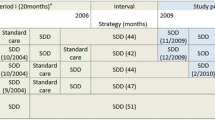Abstract
The objective of the present work was to assess the possible mechanisms of the poor efficiency of selective decontamination of the digestive tract (SDD) in medical and surgical intensive care unit (ICU) patients. Sixty-four consecutive mechanically ventilated patients received gut decontamination with polymixin E, gentamicin and amphotericin B via a nasogastric tube and were assessed for oropharyngeal, gastric and fecal colonization and for the presence of each antibiotic in the stomach and feces. A decrease in fecal colonization withEscherichia coli was observed over 20 days but not with other gram-negative bacteria or gram-positive cocci. Fifteen and 26 % of the fecal colonizing gram-negative bacteria were resistant to polymixin E and gentamicin, respectively, at admission. These proportions increased to up to 50 % after 16 days of treatment. Although 50 % of staphylococci were initially sensitive to gentamicin, all strains were resistant to this drug after four days of SDD. Both antibiotics were found in concentrations of less than 20 µg/g in 11 of 38 stools. Of these 38 stools, nine were not contaminated, 20 were colonized with resistant bacteria and 16 with strains sensitive to one antibiotic present in the stool. Therefore, the poor efficiency of gut decontamination observed was probably due to the great proportion of resistant strains on admission of the patients, to the selection of such resistant strains with SDD, to poor intestinal transit of the antibiotics, and to inactivation of the drugs by the feces. These results support stringent monitoring of fecal colonization in patients undergoing SDD in order to detect the fecal carriage of gram-positive and multiresistant gram-negative bacteria.
Similar content being viewed by others
References
Stoutenbeek CP, Van Saene HKF, Miranda DR, Zandstra DF The effect of selective decontamination of the digestive tract on colonisation and infection in multiple trauma patients. Intensive Care Medicine 1984, 10: 185–192.
Unertl, K, Ruckdeschel G, Selbmann HK, Jensen U, Forst H, Lenhart FP, Peter K Prevention of colonisation and respiratory infections in long term ventilated patients by local antimicrobial prophylaxis. Intensive Care Medicine 1987, 13: 106–113.
Ledingham IMcA, Eastaway AT, McKey IC, Alcock SR, McDonald JC, Ramsay G Triple regimen of selective decontamination of the intestine tract, systemic cefotaxime, and microbiological surveillance for prevention of acquired infection in intensive care. Lancet 1988, i: 785–790.
Kerver AJH, Rommes JH, Mevissen-Verhage EAE, Hulstaert PF, Vos A, Verhoeff J, Wittebol P Prevention of colonisation and infection in critically ill patients: a prospective randomized study. Critical Care Medicine 1988, 16: 1087–1093.
Ullrich C, Harinck de Weerd JE, Bakker NC, Jacz K, Doornbos L, De Ridder VA Selective decontamination of the digestive tract with norfloxacin in the prevention of ICU infections: a prospective randomized study. Intensive Care Medicine 1989, 15: 424–431.
Godard J, Guillaume C, Reverdy ME, Bachmann P, bui-Xuan B, Nageotte A, Motin J Intestinal decontamination in a polyvalent ICU. Intensive Care Medicine 1990, 16: 307–311.
Gastinne H, Wolff M, Delatour F, Faurisson F, Chevret S A controlled trial in intensive care units of selective decontamination of the digestive tract with non absorbable antibiotics. New England Journal of Medicine 1992, 326: 594–599.
Loirat P, Bauernfeind A, Binslev L, Falke K, Finch RG, Launois R, Reynaert M, Robotham JL, Tognoni G, Torres A, Van Der Meer JWM Selective decontamination of the digestive tract in ICU patients. First European Consensus Conference in Intensive Care Medicine. Intensive Care Medicine 1992, 18: 182–188.
Abu Zidan FMA, McAteer E, Elhag KM Selective decontamination of the digestive tract in Kuwait. Critical Care Medicine 1989, 17: 1364.
Misset B, Kitzis MD, Mahe P, Conscience G, Goldstein FW, Fournier A, Carlet J Bacteriological side effects of a gut decontamination with polymixin E, gentamicin and amphotericin B on fecal flora in general ICU patients. Infection Control and Hospital Epidemiology 1993, 14: 62–64.
Driks MR, Craven DE, Celli BR, Manning M, Burke R, Garvin GM, Kunches LM, Farber HW, Wedel SA, McCabe WR Nosocomial pneumonia in intubated patients randomized to sucralfate versus antacids and/or histamine type 2 blockers: the role of gastric colonization. New England Journal of Medicine 1987, 317: 1376–1382.
Le Gall JR, Loirat P, Alperovitch A, Glaser P, Granthil C, Mathieu D, Mercier P, Thomas R, Villers D A simplified acute physiology score for ICU patients. Critical Care Medicine 1984, 12: 975–977.
Daschner FD, Frey P, Wolff G, Baumann PC, Suter P Nosocomial infections in intensive care wards: a multicenter prospective study. Intensive Care Medicine 1982, 8: 5–9.
Garibaldi RA, Britt MR, Coleman ML Risk factors for postoperative pneumonia. American Journal of Medicine 1981, 70: 677–680.
Craven DE, Kunches LM, Kilinski V, Lichtenberg DA, Make BJ, McCabe WR Risk factors for pneumonia and fatality in patients receiving continuous mechanical ventilation. American Review of Respiratory Disease 1986, 133: 792–796.
Soussy CJ, Deforges LP, Le Van Thoi J, Feghali W, Duval JR Cefotaxime concentration in the bile and wall of the gallbladder. Journal of Antimicrobial Chemotherapy 1980, 6, Supplement A: 125–130.
Van Saene JJM, Van Saene HKF, Stoutenbeek CP, Lerck CF Influence of faeces on the activity of antimicrobial agents used for decontamination of the alimentary canal. Scandinavian Journal of Infectious Diseases 1985, 17: 295–300.
Neu HC General concepts on the chemotherapy of infectious diseases. Medical Clinics of North America 1987, 71: 1051–1064.
Sande MA, Mandell GL Antimicrobial agents: the aminoglycosides. In: Goodman AG, Gilman LS (ed): The pharmacological basis of therapeutics. Macmillan Publishing, New York, 1985, p. 1150–1169.
Fekety R Polymixins. In: Mandell GL, Douglas RG, Bennett JE (ed): Principles and practice of infectious diseases. John Wiley & Sons, New York, 1985, p. 235–237.
Author information
Authors and Affiliations
Rights and permissions
About this article
Cite this article
Misset, B., Kitzis, M.D., Conscience, G. et al. Mechanisms of failure to decontaminate the gut with polymixin E, gentamicin and amphotericin B in patients in intensive care. Eur. J. Clin. Microbiol. Infect. Dis. 13, 165–170 (1994). https://doi.org/10.1007/BF01982192
Issue Date:
DOI: https://doi.org/10.1007/BF01982192




